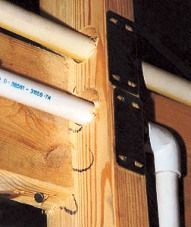Categories: Featured Articles » Electrician at home
Number of views: 44925
Comments on the article: 1
Pipes for electrical wiring
 Perhaps the most time-consuming way to install electrical wiring is to lay it in pipes. But there are times when it is simply impossible in a different way. For example, hidden wiring in wooden houses is best done in pipes, and not in corrugated pipeas is customary.
Perhaps the most time-consuming way to install electrical wiring is to lay it in pipes. But there are times when it is simply impossible in a different way. For example, hidden wiring in wooden houses is best done in pipes, and not in corrugated pipeas is customary.
The pipe provides reliable protection against mechanical damage, but under certain conditions it can also protect the cable from aggressive environmental conditions. It all depends on the material of the pipe and the method of joining its individual segments.
So for dry rooms without increased danger it is quite possible to use a steel thin-walled pipe with a cross section of 15-20 mm connected with sockets or threadless couplings as a route for electrical wiring. Moreover, if the pipe is open, then it must be painted, and if the pipe goes under concrete pouring, it is better to refrain from painting.
In humid rooms, for example, in a bathhouse, it is better to give preference to a water-gas pipe (GVP) with a diameter of 15-80 mm with a tight connection using screwed couplings. Seals in this case are also used in places where pipes are connected to junction boxes: all for the sake of tightness.
 When preparing a cable route from steel pipes, certain rules must be observed. In particular, the cut of each pipe must be deburred and countersunk. Pipe bends are allowed at an angle of at least 90 degrees. And at the same time, if two such bends are provided on the pipe segment, then its length should not exceed five meters, and if the pipe is straight, then it can be up to 10 meters long. If this rule cannot be observed, you will have to install an additional lingering box in which there will be no core connections. When bending the pipe, you must try not to crush it and not to reduce the cross section.
When preparing a cable route from steel pipes, certain rules must be observed. In particular, the cut of each pipe must be deburred and countersunk. Pipe bends are allowed at an angle of at least 90 degrees. And at the same time, if two such bends are provided on the pipe segment, then its length should not exceed five meters, and if the pipe is straight, then it can be up to 10 meters long. If this rule cannot be observed, you will have to install an additional lingering box in which there will be no core connections. When bending the pipe, you must try not to crush it and not to reduce the cross section.
Compliance with these standards is necessary in order to ensure the possibility of easy change of wiring.
Steel pipe is very susceptible to corrosion, and even painting is not always able to solve this problem. Therefore, during installation, you will have to take into account some more harmful factors. For example, moisture may accumulate in the pipe - the same condensate. To avoid this, horizontal transitions of steel pipes are performed with a slight slope towards the branch box.
In addition, since steel has excellent thermal conductivity, it is necessary to protect the conductors located in the steel pipe from extreme temperatures. Therefore, at the intersection of the wiring and heating pipes, the distance in the light between them should be at least 50 mm. And if these pipes are parallel to each other, then they must be mutually removed by 100 mm.
 If the steel pipe is mounted openly, then it must be securely fastened every 2.5 or 3 meters and near the bends. This can be done, for example, using clamps or pads.
If the steel pipe is mounted openly, then it must be securely fastened every 2.5 or 3 meters and near the bends. This can be done, for example, using clamps or pads.
Well, of course, steel pipes for electrical wiring must necessarily be included in the potential equalization system, since they are conductors and are very likely to unexpectedly acquire a dangerous electrical potential.
It can be seen that the use of steel pipes for electrical wiring is fraught with a number of problems, and therefore, such pipes are rarely used for these purposes: only when, for some reason, a very reliable mechanical protection is needed. In other cases, it is better to use a plastic pipe.
 The material of plastic pipes for electrical wiring is fairly familiar to everyone polyvinyl chloride (PVC) and high or low pressure polyethylene.These pipes are distinguished by high corrosion resistance, low cost, low weight, higher flexibility and durability compared to steel pipes.
The material of plastic pipes for electrical wiring is fairly familiar to everyone polyvinyl chloride (PVC) and high or low pressure polyethylene.These pipes are distinguished by high corrosion resistance, low cost, low weight, higher flexibility and durability compared to steel pipes.
Although the requirements for the number and curvature of bends, as well as the length of straight and bent sections for PVC and polyethylene pipes are the same as for steel, working with the former is much easier. Almost no special skills are required, since everyone can easily master the welding of plastic pipes with the help of special devices and torches.
Plastic pipes for electrical wiring are becoming increasingly popular and are replacing steel pipes. In the future, with the advent of new, more advanced plastic materials, steel pipes can be completely abandoned.
Alexander Molokov
See also at bgv.electricianexp.com
:
